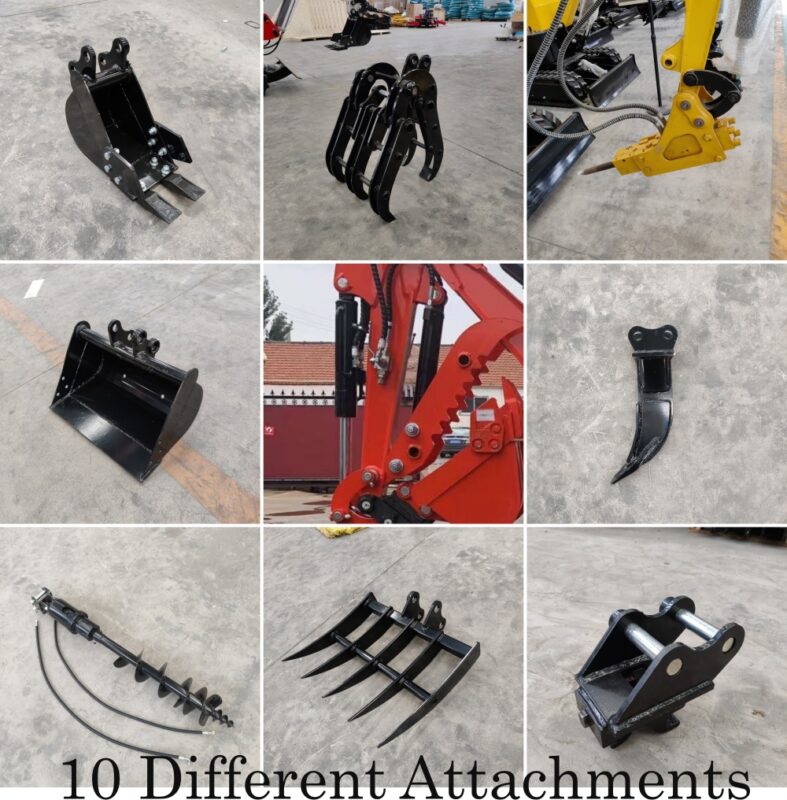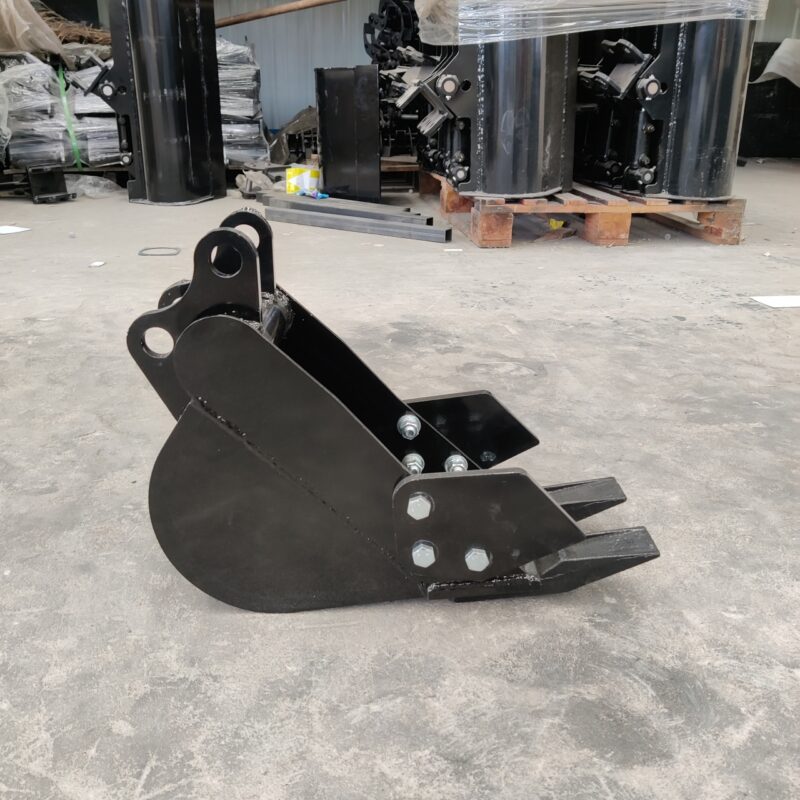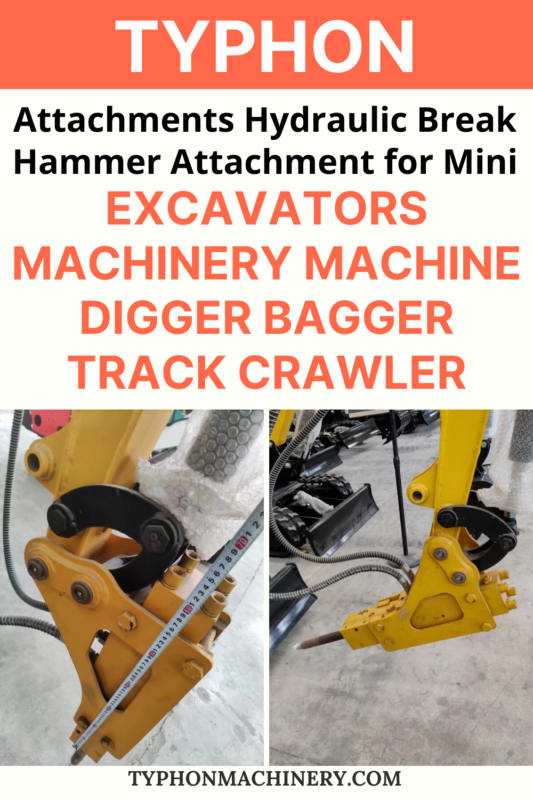Excavator
Unlock the Full Potential of Your Mini Excavator with Versatile Attachments

Introduction to Mini Excavator Attachments
A mini excavator, though inherently versatile and powerful, can achieve unparalleled efficiency and functionality with the right attachments. Opting to equip your mini excavator with various attachments transforms the machine into a multi-functional tool capable of handling a wide array of tasks. This versatility is crucial, as it allows operators to adapt to different job requirements without the need for multiple specialized machines, thereby optimizing both time and resources.
Attachments, which commonly include buckets, augers, hydraulic hammers, and grapples, among others, play a pivotal role in extending the operational capabilities of a mini excavator. For instance, switching from a standard digging bucket to a grading bucket enables precise landscaping tasks, while an auger attachment makes drilling holes for posts remarkably efficient. This adaptability is essential in industries such as construction, agriculture, and landscaping where job demands can vary significantly.
Moreover, investing in a range of attachments ensures that your mini excavator can perform at its best across diverse projects, from small-scale residential work to larger commercial undertakings. It maximizes the return on investment (ROI) by minimizing downtime associated with equipment changes and allowing seamless transition between tasks. By integrating attachments such as hydraulic thumbs or rippers, operators can streamline processes, reducing manual labor and boosting overall productivity.
In an era where efficiency and adaptability are paramount, understanding and leveraging the potential of mini excavator attachments is fundamental. Whether you are a contractor looking to diversify your service offerings or a farmer needing a reliable all-purpose machine, the right attachments provide a competitive edge. Thus, the decision to equip your mini excavator with versatile attachments is more than just an upgrade; it is a strategic move towards enhancing capability and efficiency.
Types of Attachments and Their Uses
Mini excavators are renowned for their versatility, attributable to the wide variety of attachments available. Each attachment expands the functionalities of the mini excavator, allowing it to perform tasks that would otherwise require separate, specialized equipment. This section will explore some of the most popular mini excavator attachments and their specific use cases.

The bucket attachment, perhaps the most common and essential, is used for digging and loading materials. Buckets come in various sizes and types, such as trenching buckets for narrow trenches and grading buckets for leveling and smoothing surfaces. The adaptability of buckets enhances the mini excavator’s efficiency on construction sites.

Next, hydraulic breakers are vital for demolition work. These powerful attachments can demolish concrete, asphalt, and other hard materials. By equipping your mini excavator with a hydraulic breaker, you can handle tough demolition tasks without the need for dedicated heavy machinery.
For drilling and boring operations, the auger attachment is indispensable. Augers allow mini excavators to create precise holes for fencing, landscaping, and foundational work. With a variety of auger bit sizes available, this attachment offers the flexibility to address different project requirements.
Grapples, on the other hand, are designed for handling bulky and irregularly shaped materials. Ideal for forestry, waste management, and recycling operations, grapples enable mini excavators to lift, move, and sort materials efficiently.
Other notable attachments include rippers for breaking through hard ground or frozen earth, thumbs for improved material handling, and compactors for soil compaction tasks. Each attachment converts the mini excavator into a multi-functional machine, enhancing its capability to perform a diverse range of jobs.
By understanding the specific use cases of these attachments, you can optimize your mini excavator’s performance, ensuring productivity and cost-efficiency across your projects.
Selecting the Right Attachments for Different Applications
Choosing the right attachment for your mini excavator is vital to maximizing its efficiency and productivity. The task’s nature plays a crucial role in determining the appropriate attachment. For digging operations, a standard bucket is often used; however, when precision or varying soil conditions come into play, specialized tools like trenching or grading buckets might be more effective. Soil conditions can heavily impact the performance of attachments; sandy, loose soil may require different tools compared to clay-heavy or rocky grounds.
For trenching, augers are highly recommended. They come in various diameters and can efficiently create holes for footings, fencing, or utility poles. Additionally, tilt buckets allow for angled trenches, which are beneficial in landscaping or specific utility projects. Material handling and transportation often require grapple or clam-shell buckets, ideal for managing debris, soil, or loose materials with ease. These attachments enhance the mini excavator’s versatility by enabling it to take on tasks beyond traditional digging.
In demolition applications, hydraulic breakers or compactors become invaluable. Hydraulic breakers provide powerful impact force, breaking through concrete or stone with efficiency. Compactors, on the other hand, are essential when you need to compress or flatten surfaces to create stable foundations. When handling materials, the thumb attachment offers a strong grip, making it easier to grab and move objects securely.
Precision tasks such as grading or landscaping often benefit from using a grading bucket or a laser-guided attachment to ensure accuracy. Additionally, a rotating bucket can enable more precise control when sculpting landscapes or leveling areas. Each attachment brings unique capabilities to the mini excavator, allowing operators to tackle a wide range of tasks effectively.
Selecting the right mini excavator attachment is about matching the tool to the job at hand, taking into account both the nature of the work and the environmental conditions. By carefully considering these factors, you can unlock the full potential of your mini excavator, transforming it into a powerful, multi-functional machine capable of handling several applications efficiently and with greater precision.
Installation and Maintenance of Attachments
When utilizing a mini excavator, the proper installation and maintenance of its attachments cannot be overemphasized. Ensuring that attachments are securely fitted and well-maintained extends their lifespan and enhances operational efficiency. To begin with, always refer to the manufacturer’s manual for specific instructions tailored to your mini excavator model. Generally, the installation process involves aligning the attachment with the quick attach system or pin coupler, ensuring that all pins and locks are securely fastened.
Begin by positioning the attachment on a stable surface. Lower the mini excavator’s coupler to align with the attachment’s connection points. Engage the coupler and lock it in place, ensuring all safety pins are inserted. For hydraulic attachments, connect the hydraulic hoses, taking care to prevent contamination with dirt or debris, which can damage the hydraulic system.
Once the attachment is securely installed, perform a functionality test. Operate the mini excavator to check if the attachment moves smoothly and responds correctly to controls. This is crucial for verifying that the hydraulic and mechanical connections are working as intended.
To maintain your mini excavator attachments, adhere to a routine inspection schedule. Check for any signs of wear, cracks, or rust that could compromise the safety and effectiveness of the attachment. Regularly lubricate moving parts to reduce friction and wear. Ensure hydraulic connections are tight and free of leaks, as leaking fluid can indicate a serious issue. Replace damaged hoses immediately to avoid further mechanical failures.
Moreover, always clean attachments after each use, removing any soil, debris, or moisture that could cause rust or other forms of damage. Store attachments properly when not in use, preferably in a dry, sheltered location to protect them from the elements. Following these installation and maintenance steps will help you get the most out of your mini excavator attachments, ensuring they remain reliable and efficient for years to come.
Enhancing Productivity with Multi-Function Attachments
In the fast-evolving field of construction and landscaping, mini excavators have emerged as essential machinery tools. Their utility is significantly enhanced through a broad range of multi-function attachments that allow them to perform multiple tasks seamlessly. These versatile mini excavator attachments not only expand operational capabilities but also amplify productivity and cost-effectiveness on various projects.
One notable example of a multi-function attachment is the hydraulic thumb. This simple yet effective tool converts the mini excavator into a robust material handling machine. It enables operators to grab, lift, and move objects like logs, debris, and stones with precision, which traditionally would require additional specialized machinery. The adaptability of the hydraulic thumb makes it indispensable in both construction and landscaping projects, significantly cutting down both time and labor costs.
Another such attachment is the auger, known for its versatility in drilling holes for fence posts, tree planting, and even foundation supports. Modern augers often come with various drill bit sizes and configurations, making them adaptable for a wide range of soil conditions and project requirements. The ability to swiftly switch between bits or attachments on-site minimizes downtime and enhances workflow efficiency, making the auger a multifaceted asset.
The tilting bucket is another prominent multi-function attachment that offers enhanced control and flexibility. With its ability to tilt in various angles, it is ideal for grading, leveling, and shaping terrains. This level of precision can drastically reduce the necessity for manual adjustments post-excavation, thereby streamlining operations and yielding better project outcomes. Moreover, tilting buckets often feature quick coupling systems, facilitating rapid transitions between different attachments and further augmenting productivity.
Ultimately, the integration of multi-function attachments transforms a mini excavator into a powerhouse of efficiency and versatility. These tools not only streamline diverse tasks but also eliminate the need for employing multiple specialized machines, leading to substantial cost savings. By leveraging such advanced attachments, businesses can unlock new levels of productivity and operational agility, ensuring projects are completed more efficiently and economically.
Case Studies: Real-World Applications and Success Stories
Mini excavator attachments have significantly transformed the capabilities of these compact machines, enabling users to undertake a diverse range of tasks with enhanced efficiency. One notable example is a small landscaping business in Oregon that integrated a range of attachments to streamline operations. By employing a mulching head, the company successfully managed to clear large plots of overgrown land in a fraction of the time it previously took using traditional methods. This not only improved project turnaround times but also reduced labor costs, propelling the business to scale new heights.
Another compelling success story involves a construction firm in Texas that specializes in urban development projects. Faced with the challenge of working in confined urban spaces, the firm invested in a suite of mini excavator attachments, including a hydraulic breaker and a trenching bucket. These attachments enabled them to break through concrete and dig precise trenches for utility installations more efficiently than ever before. The operational flexibility provided by these attachments enhanced their project workflow, resulting in increased client satisfaction and subsequent contract wins.
In the agricultural sector, a family-owned farm in Iowa utilized mini excavator attachments to maximize productivity. By employing a post-hole auger and a brush cutter, they expedited the process of fence installation and land clearing. The adaptability of the mini excavator allowed them to execute various seasonal tasks without the need to hire additional equipment, thereby achieving significant cost savings. The farm reported a marked increase in operational efficiency and maintained punctuality during peak farming seasons.
Lastly, a municipality in New York leveraged mini excavator attachments for public works and maintenance projects. The addition of a grading blade and a grapple attachment enabled the efficient grading of roads and the handling of debris, facilitating the timely upkeep of community infrastructure. Feedback from city officials highlighted the impact of these attachments in reducing project durations and minimizing disruptions to public services.
These case studies illustrate the profound benefits and versatility of mini excavator attachments across various industries. Whether in landscaping, construction, agriculture, or public works, the strategic application of these attachments has proven to be a game-changer, driving productivity and operational efficiency to new levels.
Cost-Benefit Analysis of Investing in Attachments
Investing in versatile attachments for a mini excavator can be a financially prudent decision. The initial costs of purchasing these attachments can vary widely, depending on the type and sophistication of the equipment. Common attachments include buckets, augers, breakers, and grapples, each designed for specific tasks. While the upfront expense might seem significant, it is essential to consider the extensive long-term benefits.
One of the most notable advantages of utilizing mini excavator attachments is the increase in operational efficiency. Attachments can transform a basic machine into a multi-functional asset, capable of performing a diverse range of tasks with precision and speed. This eliminates the need for manual labor, leading to substantial savings in labor costs over time. For instance, using a hydraulic breaker attachment can complete demolition jobs faster than traditional methods, thus reducing labor hours needed for the task.
Beyond labor savings, enhanced efficiency from these attachments often results in faster project completion times. This ability to expedite job timelines not only increases the number of projects a business can take on but also augments profitability due to improved turnaround times. For example, an auger attachment for drilling tasks can significantly cut the time required for hole creation, enabling operators to move onto new projects more swiftly.
Furthermore, the financial viability is amplified through the minimization of equipment rental costs. Owning a variety of attachments means operators can undertake a broader spectrum of projects without the need to rent specialized equipment, which can be costly. This versatility opens doors to new business opportunities, allowing companies to tackle projects ranging from landscaping to construction with a single mini excavator equipped with the appropriate attachments.
In comprehensive terms, the initial investment in mini excavator attachments is often offset by the cumulative benefits of reduced labor costs, heightened efficiency, and the potential to diversify service offerings. Prospective buyers are encouraged to perform a detailed cost-benefit analysis, tailored to their specific needs and project scopes, to ensure that this investment aligns with their financial and operational goals.
Future Trends in Mini Excavator Attachments
As the demand for mini excavators continues to rise across various industries, the need for more versatile and efficient attachments is becoming increasingly apparent. Emerging trends and technological advancements are set to revolutionize the field of mini excavator attachments, offering unprecedented capabilities and operational efficiencies.
One of the most significant trends is the development of smart attachments. These innovative tools are integrated with sensors and IoT technology to communicate with the mini excavator, providing real-time feedback and data analytics. For instance, smart buckets can monitor the amount of material being moved, while advanced grading attachments can offer precise control for alignment and leveling tasks. Such innovations not only enhance productivity but also reduce the likelihood of errors, leading to cost savings and improved project outcomes.
Automation is another area where mini excavator attachments are seeing remarkable advancements. Automated systems can perform repetitive tasks such as digging, material handling, and trenching with greater accuracy and speed than manual operations. These solutions are particularly beneficial in hazardous environments, where minimizing human involvement can significantly reduce safety risks. With ongoing advancements in machine learning and robotics, future mini excavator attachments are expected to become even more autonomous and adaptable to varying job site conditions.
Material technology is also experiencing breakthroughs that promise to make mini excavator attachments more durable and efficient. The use of advanced composites, high-strength alloys, and wear-resistant materials can extend the service life of attachments, thereby reducing downtime and maintenance costs. Additionally, lightweight materials can enhance the maneuverability and fuel efficiency of mini excavators, allowing operators to accomplish more work with less effort and environmental impact.
These technological advancements in mini excavator attachments are poised to reshape the future of construction, landscaping, agriculture, and other industries relying heavily on these versatile machines. By embracing these innovations, businesses can unlock new levels of efficiency, safety, and profitability, ensuring they stay competitive in an ever-evolving marketplace.
